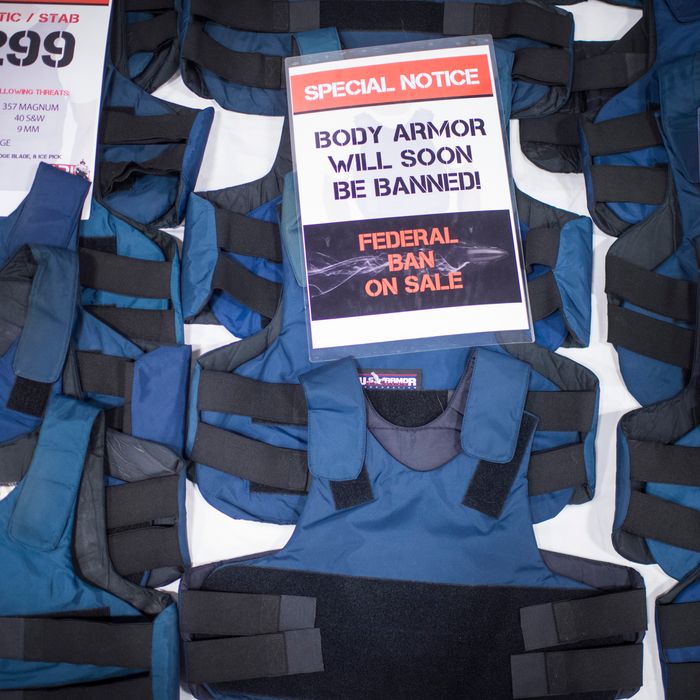
The gunman who killed 19 children in a single classroom in Uvalde, Texas, wasn’t quite as prepared as the 18-year-old who killed ten people in a supermarket in a racist attack in Buffalo just 10 days before.
To protect themselves, both gunmen wore bulletproof vests known as tactical plate carriers, designed for soldiers to insert heavy ceramic plates in the front and back panels to protect their torsos from gunfire. In Buffalo, the shooter, according to a pre-rampage screed, wore expensive plates that could stop bullets from an AK-47 — and did stop a less powerful bullet fired from an armed guard’s handgun. But in Texas, officials say the shooter did not wear plates at all, making the plate carrier useless. “It’s just nylon,” says pistol instructor Nick Humphries.
Even if the killer in Uvalde did not wear the vest as intended, he joins a growing line of American mass murderers who have turned to body armor to make their attacks more deadly. Over the past decade, the vests have become an increasingly common feature of such shootings, worn in a Boulder supermarket attack in 2021 that killed ten; the Sutherland Springs church shooting in 2017 that killed 26; the San Bernardino shooting in 2015 that killed 16; and the movie theater shooting in Aurora in 2012 that killed 12. The Pulse shooter who killed 49 people tried to buy one. A shooter in Virginia Beach left his at home. They have been worn in many other attacks you probably forgot about, pushed out of memory by more and more tragic and preventable shootings each year. According to a mass-shooting database compiled by The Violence Project, 21 mass shooters over the last 40 years in attacks “not attributable to any other underlying criminal activity or commonplace circumstance” have worn some form of body armor.
Some criminologists have identified the trend as a way for ideologically motivated shooters to attract focus to their cause. “It’s meant to have people pay attention and to notice it,” criminal justice professor James Densley, co-founder of the Violence Project, told the Associated Press. “One of the ways you do that is you dress up pretending you’re in the military.” But a psychological explanation obscures a simpler reason for its rise: Body armor helps these killers kill more people.
The Buffalo shooter knew this. In a manifesto shortly before his attack, he wrote that he needed a plate carrier vest to “minimize the chance of instant death” from a security officer. He claimed to have bought two plates from a manufacturer called RMA Armament, a company founded in 2013 by an ex-Marine who named it after the initials of his three daughters. The ceramic plates are designed to break apart the bullet on impact, diffusing the bullet’s lethal energy, at which point dense, plastic polymer fibers absorb the fragments “like a catcher’s mitt,” according to technical specs. The RMA plates cost more than $300 each and are tested to the standards of the Department of Justice’s research agency to stop rounds from popular assault rifles like the AR-15.
During the attack in Buffalo, security guard Aaron Salter fired at the shooter but “did not penetrate the body armor,” according to Buffalo’s mayor. Salter’s bullet may have stopped him if the shooter did not have a vest; instead, Salter, a retired police officer, was killed in their exchange of fire.
With body armor sales to the public surging in the U.S., police have had to adapt their tactics. Traditionally, officers are trained to shoot people in the torso, what’s known as “center of mass.” Aaron Westrick, a professor of criminal justice at Lake Superior State University, says that the “center of mass has actually moved up” on standard police-qualification targets, the body-shaped silhouettes cops use to train on the gun range. “Center of mass used to say the torso, so from the navel up to the shoulders, across the shoulders,” he says. “Now a lot of the targets come up from the center toward the head and neck area.” But the shifting target poses an obvious problem: The head is a much smaller target than the torso. And in cases such as Buffalo, gunmen also wear ballistic helmets, making a fatal shot from a “good guy with a gun” even more difficult.
Body armor faces few restrictions in the United States, where adults who have not been convicted of a felony can buy vests and plates online in every state except Connecticut, where they must be purchased directly from a dealer. Efforts to control sales have stalled on the national level. In 2019, following a rampage in Ohio where the assailant wore body armor, New York Senator Chuck Schumer proposed a bill requiring FBI permission before anyone outside of law enforcement could buy “sophisticated” armor like plate carrier vests. It failed before it reached the Senate floor, along with legislation to curtail the sale of the assault rifles that make these shootings so deadly in the first place.






























